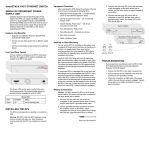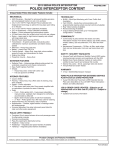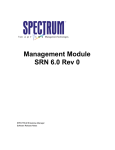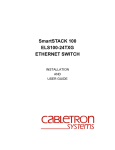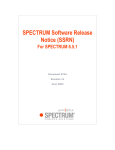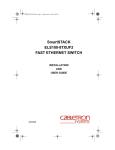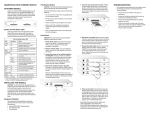Download Cabletron Systems 24 User`s guide
Transcript
USER’S GUIDE ADDENDUM SMARTSTACK ELS100-24 FIRMWARE REVISION 2.01 9033194 Cabletron Systems, Inc. PO Box 5005 Rochester, NH 03866-5005 This addendum is to be used in conjunction with the Installation and User Guide that ships with the Cabletron SmartSTACK 100 ELS100-24TXG and/or ELS100-24TXM Ethernet Switches. This document contains proprietary information that is the property of Cabletron Systems, Inc. No part of this publication may be reproduced, stored in a retrieval system, translated, transcribed, or transmitted, in any form, or by any means, manual, electric, electronic, electromagnetic, mechanical, chemical, optical, or otherwise, without prior explicit written permission of Cabletron Systems, Inc. Furthermore, Cabletron Systems, Inc. reserves the right to revise this publication and to make changes in content from time to time without obligation to provide notification of such revision or changes. © Copyright 1999 by Cabletron Systems All Rights Reserved Printed in the United States of America Order Number: 9033194 August 1999 Cabletron Systems, SPECTRUM, LANVIEW, and MicroMMAC are registered trademarks and SmartSwitch is a trademark of Cabletron Systems, Inc. All other product names mentioned in this manual may be trademarks or registered trademarks of their respective companies. TABLE OF CONTENTS SMARTSTACK ELS100-24 FIRMWARE REVISION 2.01 . . . . . . . . . . . . . . . . . . 1 A.1 Introduction . . . . . . . . . . . . . . . . . . . . . . . . . . . . . . . . . . . . . . . . . . . . 1 A.2 User Interface Menu Hierarchy. . . . . . . . . . . . . . . . . . . . . . . . . . . . . 2 A.3 SmartTrunking . . . . . . . . . . . . . . . . . . . . . . . . . . . . . . . . . . . . . . . . . 3 Background . . . . . . . . . . . . . . . . . . . . . . . . . . . . . . . . . . . . . . . . . . . 3 A.3.1 Configuring SmartTrunking: User Interface . . . . . . . . . . . . . . 5 A.3.1.1 SmartTrunking Configuration Menu. . . . . . . . . . . . . . . . . . . 5 A.3.1.2 Spanning Tree Trunk Configuration Menu . . . . . . . . . . . . . 9 A.3.2 Configuring SmartTrunking: Web-Based Management . . . . 11 A.3.2.1 SmartTrunking Configuration . . . . . . . . . . . . . . . . . . . . . . 11 A.4 Half Duplex Support on 100Base-FX Ports . . . . . . . . . . . . . . . . . . 13 A.5 Read-only Password Protection . . . . . . . . . . . . . . . . . . . . . . . . . . . 14 A.6 Disable Serial Console . . . . . . . . . . . . . . . . . . . . . . . . . . . . . . . . . . 15 A.7 Syslog . . . . . . . . . . . . . . . . . . . . . . . . . . . . . . . . . . . . . . . . . . . . . . . 15 A.7.1 User Interface . . . . . . . . . . . . . . . . . . . . . . . . . . . . . . . . . . . . 15 A.8 MIB Enhancements . . . . . . . . . . . . . . . . . . . . . . . . . . . . . . . . . . . . 17 A.8.1 802.1p and 802.1Q MIB . . . . . . . . . . . . . . . . . . . . . . . . . . . . 17 A.8.2 Interfaces MIB: RFC 2233 . . . . . . . . . . . . . . . . . . . . . . . . . . 17 A.8.3 Cabletron Proprietary MIB . . . . . . . . . . . . . . . . . . . . . . . . . . 18 A.8.4 SmartTrunking MIB . . . . . . . . . . . . . . . . . . . . . . . . . . . . . . . 19 A.9 Power Up Diagnostics . . . . . . . . . . . . . . . . . . . . . . . . . . . . . . . . . . 20 A.10 Web Management Enable . . . . . . . . . . . . . . . . . . . . . . . . . . . . . . 20 9033194 Table Of Contents i ADDENDUM A. SMARTSTACK ELS100-24 FIRMWARE REVISION 2.01 A.1 Introduction The Cabletron SmartSTACK ELS100-24 firmware revision 2.01 supports the following models of the ELS100-24 product family: • ELS100-24TX • ELS100-24TXM • ELS100-24TXG Firmware revision 2.01 provides the following new features: • SmartTrunking - Allows multiple physical ports of the switch to be aggregated together to form a single logical connection between network devices. • Half-duplex support on 100Base-FX ports - Enables half duplex operation on 100Base-FX ports. • Read-only password - Adds an additional password option to the user interface (serial console and Telnet) for read-only access. • Disable serial console option - Adds a variable to SNMP allowing the serial console of the switch to be disabled or enabled. • Syslog feature - Allows various types of errors encountered by the switch software to be logged to an external server. • MIB Enhancements 802.1p and 802.1Q MIB: Adds partial support for the IETF MIBs for configuring 802.1p (priority) and 802.1Q (VLANs). RFC 2233 MIB: Adds support for the Stack Table portion of RFC 2233, extensions to the Interfaces MIB. Cabletron MIB Extensions: Adds several new variables to the Cabletron MIB. SmartTrunking MIB: Adds a new proprietary MIB for configuring SmartTrunking. The following two features were available in the previous Cabletron SmartSTACK ELS100-24 firmware version, but were not documented: 9033194 • Power Up Diagnostics - Allows you to enable a switch functionality self-test upon initialization. • Web Management Enable - Allows you to enable switch management over the web. SmartSTACK ELS100-24 Firmware Revision 2.01 1 A.2 User Interface Menu Hierarchy Figure A-1 shows the user interface hierarchy for the Cabletron SmartSTACK ELS100-24, firmware revision 2.01. System Configuration Menu Switch Configuration Menu SNMP Configuration Menu System Name System Location System Contact IP Address Subnet Mask Default Gateway BootP/DHCP Enable Screen Timeout (minutes) READ/WRITE Password READ ONLY Password Terminal Baud Rate Power Up Diagnostics Syslog Server IP Address Lowest Syslog Severity Level Web Management Enable Forwarding Table Configuration Menu Spanning Tree Configuration Menu VLAN Configuration Menu Forwarding Table Aging Time (seconds) Broadcast Cutoff Rate Port Mirroring Enable Mirrored Port Transmit Data Mirror Enable Mirroring Port Receive Data Mirror Enable Class of Service Configuration Menu Trunking Configuration Menu SNMP Private Community Name SNMP Public Community Name Trap Destination #1-4 Community Name #1-4 Display Table Make Entry Static Add Static Entry Delete Static Entry Modify Static Entry Search by Port# Search by MAC Address Spanning Tree Protocol Enable Port Configuration Menu Hello Time (seconds) Forward Delay (seconds) Max Age (seconds) Bridge Priority SmartTrunking Configuration Menu Port ID Port Name Path Cost Port Priority Port State Select Port VLAN Enable VLAN Menu VLAN Port Menu ID VLAN Name Ports in VLAN VLAN Egress Ports Configure Class of Service Enable Priority Threshold Configure Port Priority Port Menu ID Port Name Enable Status Link Status Auto Negotiated Status Full Duplex Status Speed (10/100Mbps) Type Flow Control Status Configure ID Name Ports in Trunk Configure ID Transmitted Received Forwarded Filtered Dropped Errored Switch Summary Port Statistics Trunking Statistics Frames Transmitted Frames Received Frames Forwarded Frames Filtered Frames Dropped Frames Errored Switch Statistics Screen Port ID Port Name Type Modify Port Type Port ID Port Name Priority Default Configure Trunk Number Add Ports Remove Ports Smart Trunk Name Protocol Enable Port #n Statistics General Information Screen Software Version Serial Number Base MAC Address Up Time (minutes) Power Up Count Download Software Menu Save Current Configuration Return to Default Configuration Logout Reset Frames Transmitted Frames Received Frames Forwarded Frames Filtered Frames Dropped Broadcasts Transmitted Broadcasts Received Multicasts Transmitted Multicasts Received Bytes Transmitted Bytes Received Pause Frames Transmitted Pause Frames Received Collisions Late Collisions CRC/Alignment Errors Undersized Frames Oversized Frames Fragments Jabbers 64 Byte Frames 65 to 127 Byte Frames 128 to 255 Byte Frames 256 to 511 Byte Frames 512 to 1023 Byte Frames 1024 to 1518 Byte Frames Figure A-1. User Interface Menu Hierarchy 2 SmartSTACK ELS100-24 Firmware Revision 2.01 9033194 A.3 SmartTrunking SmartTrunking is a link aggregation feature that allows multiple physical ports of the switch to be aggregated together to form a single logical connection between network devices. All physical connections in the logical connection carry traffic, as compared with previous software versions in which Spanning Tree would block all traffic on all but one of the physical connections. Background A trunk is a group of ports that perform as a single logical port, connecting the ELS100-24 switch with another network device. Compared with a single port, the group of ports in a trunk feature increased bandwidth and provide a level of connection resiliency - when one physical port link in the trunk group goes down, the overall connection is not lost. When a port in a trunk group is removed (link goes down or a cable is severed), traffic on that port will be redistributed to other ports in the trunk group. In the example in Figure A-2 below, three switches are connected (stacked) through a series of trunk groups. Two physical ports are combined to form each trunk group. The fiber ports in the top switch form Trunk 1 which carries traffic to the network backbone. Figure A-2. Trunking Application Example SmartTrunking uses the DEC Hunt Group protocols - PLAP and LLAP to automatically establish and maintain a trunk connection. Use of these protocols can be enabled or disabled as desired. When the protocols are 9033194 SmartSTACK ELS100-24 Firmware Revision 2.01 3 enabled, the switch is SmartTrunk-compliant and will automatically configure to work with Cabletron products such as a Smart Switch Router (SSR), SmartSwitch, SmartSTACK, etc. When the protocols are disabled, the switch can be manually configured to interoperate with trunking implementations used by other vendors. SmartTrunking support in firmware revision 2.01 follows these configuration rules: • There can be up to 2 trunk groups configured per switch cluster (group of 8 ports). • Individual trunk groups can be defined only in one cluster, not across clusters. • There can be from 2-8 ports defined per trunk group. • There can be up to 6 trunk groups defined per switch. • Ports in a trunk group can operate in any combination of speed and duplex mode (10 half with 100 full, for example). • Ports in a trunk group must be in the same VLAN and have the same VLAN mode (hybrid/access). • The Gigabit Ethernet ports on the ELS100-24TXG cannot be trunked. Further information on SmartTrunking can be found in the Cabletron Systems SmartTrunk User’s Guide. To examine this guide, see the Cabletron Systems user manual website at: http://www.cabletron.com/support/manuals The implementation of SmartTrunking in firmware version 2.01 on the ELS100-24 product line differs in several ways from the information contained in the SmartTrunk User's Guide. The primary differences in the ELS100-24 implementation are as follows: • Full load balancing of traffic across ports in a trunk is not supported. Unicast traffic is sent to the same port that the destination MAC address of the packet was learned. • Although it is highly recommended, Spanning Tree does not have to be enabled to use SmartTrunking. • The ports in a trunk are not required to operate in full duplex mode, but can be operated in any combination of half duplex or full duplex. • If a port in a trunk goes down, traffic on that port is redirected onto other links in the trunk whether protocols are enabled or disabled. • If protocols are disabled, inadvertently configuring a user-attached port to a SmartTrunking trunk group will not result in the user losing network connectivity. • The concept of logical ports, each comprised of the physical ports in a trunk group, is not implemented. In both the User Interface and SNMP, both physical port and trunk numbers can be accessed. However, port-related configuration features, such as port mirroring, VLANs, Class of Service, and Spanning Tree, are performed only on a physical port basis, not a logical port (trunk) basis. 4 SmartSTACK ELS100-24 Firmware Revision 2.01 9033194 A.3.1 Configuring SmartTrunking: User Interface SmartTrunking can be configured through the user interface. Ports that are members of a trunk group are indicated as such by an asterisk ’ * ’ next to the port number on the Port Menu of the user interface. A.3.1.1 SmartTrunking Configuration Menu To configure Trunking, do the following: 1. Select Switch Configuration Menu from the Main Menu. 2. Select Trunking Configuration Menu. Figure A-3 shows the Trunking Configuration menu. TRUNKING CONFIGURATION Trunking Enabled Trunking Protocol Access Control: READ/WRITE Yes Yes ID NAME PORTS IN TRUNK --------------------------------------------------------------------------------------------d. Protocol Enable e. Enable x. Previous Menu Enter Selection: Figure A-3. Trunking Configuration Menu 9033194 SmartSTACK ELS100-24 Firmware Revision 2.01 5 Table A-1 describes fields and options available in the Trunking Configuration menu. Table A-1. Trunking Configuration Menu Description Fields/Options Description Trunking Enabled Indicates whether trunking is enabled (Yes) or disabled (No). Trunking Protocol Indicates whether trunking protocols are enabled (Yes) or disabled (No). ID Lists the trunk group ID number. Name Lists the trunk group name (1-14 characters). Ports inTrunk Lists the ports in the trunk group. Configure Option that allows you to create a new, or configure an existing, trunk group. Delete Option that allows you to delete an existing trunk group. 3. Select c from the Trunking Configuration menu to configure trunking. The following message appears: Enter Trunk Number (1-6): 4. Enter a trunk group number. In this example, enter the number 1. Press [Enter]. Figure A-4 shows the Trunk Configuration menu with trunk group number 1. TRUNK 1 CONFIGURATION Name Trunk Status Trunking Protocol Access Control: READ/WRITE CONNECTED No PORT ENABLED LINK STATUS --------------------------------------------------------------------------------------------a. Add Port(s) d. Protocol Enable b. Remove Port(s) x. Previous Menu c. Trunk Name c. Configure d. Delete x. Previous Menu Enter Selection: Figure A-4. Trunk Configuration Menu 6 SmartSTACK ELS100-24 Firmware Revision 2.01 9033194 Table A-2 describes the Trunk Configuration menu. Table A-2. Trunking Configuration Menu Description Field Description Name Lists the trunk group name. Use the Trunk Name option to create a trunk group name (1-14 characters). Trunk Status Lists the trunk group status: PARTIAL (one or more of the trunk group ports are linked and one or more are not linked), CONNECTED (all ports in the trunk group are linked), DISCONNECTED (no ports in the trunk are linked). Trunking Protocol Indicates whether trunking protocols are enabled (Yes) or disabled (No). Port Identifies the port by number. Enabled Indicates whether the port is enabled (Yes) or disabled (No). Link Status Indicates port link status: connected or disconnected. Selection Description Add Port(s) Allows you to add port(s) to the trunk. Remove Port(s) Allows you to remove port(s) from the trunk. Trunk Name Allows you to create a unique trunk group name (1-14 characters). Protocol Enable Allows you to enable (Yes) or disable (No) the operation of the trunking protocols on this trunk. 5. Select a to add ports. The following message appears: Enter Port Number(s) or Range of Port(s) 1-26: 9033194 SmartSTACK ELS100-24 Firmware Revision 2.01 7 6. In this example, a range of ports is entered to form a trunk group. Enter 1-4 and press [Enter]. Figure A-5 shows the update to the screen. TRUNK 1 CONFIGURATION Name Trunk Status Trunking Protocol Access Control: READ/WRITE CONNECTED No PORT ENABLED LINK STATUS --------------------------------------------------------------------------------------------1 Yes CONNECTED 2 Yes CONNECTED 3 Yes CONNECTED 4 Yes CONNECTED a. Add Port(s) d. Protocol Enable b. Remove Port(s) x. Previous Menu c. Trunk Name Enter Selection: Figure A-5. Adding a Range of Ports to a Trunk 7. To add a trunk name, enter c. The following message appears: Enter Trunk Name: 8. Enter a trunk name. In this example, enter Backbone and press [Enter]. This new name appears in the Name field. 9. Enter x to return to the previous menu. Figure A-6 shows the ports that have been configured in trunk group 1. TRUNKING CONFIGURATION Trunking Protocol Access Control: READ/WRITE No ID NAME PORTS IN TRUNK --------------------------------------------------------------------------------------------1 Backbone 1-4 c. Configure d. Delete e. Enable x. Previous Menu Enter Selection: Figure A-6. Ports Configured in a Trunk Group 10. To view Trunking Statistics, return to the Main Menu, and select Switch Statistics, then Trunking Statistics. When displaying statistics for a trunk group, the statistics are the sum of the statistics for all physical ports in the trunk group. 8 SmartSTACK ELS100-24 Firmware Revision 2.01 9033194 When configuring trunk groups, consider the following: • When adding or removing port(s), the following message appears: Enter Port Number(s) or Range of Port(s) You can enter individual ports, separated by a comma, or a range of ports separated by a hyphen. • Protocol Enable either enables or disables a proprietary Cabletron protocol to be run by the switch for purposes of automatically establishing and maintaining a trunk. If the protocol is enabled, the switch uses the proprietary DEC Hunt Group protocol to detect when multiple links are established between two devices, and then automatically set up a trunk. Normally, Spanning Tree would detect multiple links, and block all but one. However, with trunking, multiple paths are valid. Protocols should be enabled when connecting the SmartSTACK switch to other Cabletron devices, or any other devices using the DEC Hunt Group protocol. If the protocol is disabled, trunks should be manually configured using the user interface, SNMP, or web access. A.3.1.2 Spanning Tree Trunk Configuration Menu Trunking operation relative to Spanning Tree can be viewed through the user interface. To view trunking configuration for Spanning Tree, do the following: 1. Select Switch Configuration Menu from the Main Menu. 2. Select Spanning Tree Configuration Menu. 3. Select Trunking Configuration Menu. Figure A-7 shows an example of the Spanning Tree Trunk Configuration menu. SPANNING TREE TRUNK CONFIGURATION Access Control: READ/WRITE TRUNK ID TRUNK NAME PATH COST PORT PRIORITY PORT STATE ------------------------------------------------------------------------------------------------------------------------2 Server3 2 0 DISABLED 3 Backbone 2 0 DISABLED r. Refresh x. Previous Menu Enter Selection: Figure A-7. Spanning Tree Trunk Configuration Menu Table A-3 describes fields and options available in the Spanning Tree Trunk Configuration menu. 9033194 SmartSTACK ELS100-24 Firmware Revision 2.01 9 Table A-3. Spanning Tree Trunk Configuration Menu Description Field/Option Description Trunk ID Lists the trunk group ID. Trunk Name Lists the trunk group name. Path Cost The contribution of the path through this port when it is the root port to the total path cost from this bridge to the root bridge: 10 for 100 Mbps ports, 100 for 10 Mbps ports. Port Priority The relative priority of the port on the bridge. Port State The current Spanning Tree state of the port on the bridge, either: disabled, listening, learning, forwarding, or blocking. Refresh Refreshes the screen to reflect latest system conditions. 10 SmartSTACK ELS100-24 Firmware Revision 2.01 9033194 A.3.2 Configuring SmartTrunking: Web-Based Management SmartTrunking can be configured through a web browser-based utility which allows you to configure and manage Cabletron SmartSTACK ELS100-24 switches remotely. For more information, see the Cabletron WebView, Web-Based Management for the ELS100-24 User Guide. To examine this guide, see the Cabletron Systems user manual website at: http://www.cabletron.com/support/manuals A.3.2.1 SmartTrunking Configuration To configure SmartTrunking, do the following: 1. Select the Switch Configuration link from the Main Menu of Cabletron Webview. 2. Select Trunking Configuration menu. Figure A-8 shows the Trunking Configuration menu. Figure A-8. Trunking Configuration Menu 3. 9033194 To enable SmartTrunking on the switch, select "Yes" from the Trunking Enable drop-down menu, then select Apply. SmartSTACK ELS100-24 Firmware Revision 2.01 11 4. Select Trunking Table Configuration. Figure A-9 shows the Trunking Table Configuration menu. Figure A-9. Trunking Table Configuration Menu 5. To create a new trunk group, select Create New Trunk. Figure A-10 shows the Create New Trunk menu. Figure A-10. Create New Trunk Menu 6. Enter the Trunk ID, the Trunk Name, the Trunking Protocol status, and the ports in the trunk, then select Apply. 12 SmartSTACK ELS100-24 Firmware Revision 2.01 9033194 7. To modify an existing trunk group, first choose the trunk to modify by selecting the radio button next to the appropriate trunk on the Trunking Table Configuration menu (Figure A-9). Then select Modify Trunk. Figure A-11 shows the Modify Trunk menu. Figure A-11. Modify Trunk Menu A.4 Half Duplex Support on 100Base-FX Ports Half duplex support on 100Base-FX ports of the ELS100-24TXM has been added in firmware revision 2.01. Previously, only full duplex operation was supported on 100Base-FX ports. Figure A-12 shows the Port Configuration menu and the Full Duplex option. Half Duplex operation is enabled when you set Full Duplex to No. PORT 1 CONFIGURATION a. Port Name b. Port Enable c. Flow Control Enable d. Full Duplex e. Port Speed Access Control: READ/WRITE Val d’Or Yes Yes No 100 x. Previous Menu Enter Selection: Figure A-12. Port Configuration Menu 9033194 SmartSTACK ELS100-24 Firmware Revision 2.01 13 A.5 Read-only Password Protection Read-only password protection has been added in firmware revision 2.01. This feature adds an additional password option to the user interface (for serial console and Telnet) for read-only access. Previously only read/ write password protection was available. To configure read-only password protection, do the following: 1. Select System Configuration Menu from the Main Menu (Figure A-13). SYSTEM CONFIGURATION a. SNMP Configuration Menu b. System Name c. System Location d. System Contact e. IP Address f. Subnet Mask g. Default Gateway h. BootP/DHCP Enable i. Screen Timeout (minutes) j. READ/WRITE Password k. READ ONLY Password l. Terminal Baud Rate m. Power Up Diagnostics n. Syslog Server IP Address o. Lowest Syslog Severity Level p. Web Management Enable Access Control: READ/WRITE 000.000.000.000 000.000.000.000 000.000.000.000 Yes 0 9600 Yes 000.000.000.000 warning Yes x. Previous Menu Enter Selection: Figure A-13. System Configuration Menu 2. Select READ ONLY Password. The following message appears: Enter New Password: 3. Enter a password containing six to eight alphanumeric characters and press [Enter]. The following message appears: Re-enter New Password: 4. Enter the password again and press [Enter] to confirm. If the password is re-entered correctly, the following message appears: Password Changed Press any Key to Continue Refer to the Installation and User Guide, Chapter 3, “Setting Password Protection” for more information. 14 SmartSTACK ELS100-24 Firmware Revision 2.01 9033194 A.6 Disable Serial Console A new MIB variable was added to the Cabletron proprietary MIB allowing the serial console of the switch to be disabled or enabled via SNMP. Previously, the serial console was always enabled. The name of the variable is SysComPortEnable as shown in the table in A.8.3 Cabletron Proprietary MIB below. Make sure the switch IP address is recorded in an easy to locate place. If the serial console is disabled, and the IP address of the switch is forgotten, the switch cannot be managed. A.7 Syslog The syslog capability was added to firmware revision 2.01, enabling the switch to forward information about errors and other conditions encountered by the software. If the switch encounters an operational error, it can be configured to log this occurrence to an external syslog (UNIX) server. The web interface can be also be used to configure syslog. A.7.1 User Interface The IP address of the external syslog server is configured using the Syslog Server IP Address option in the System Configuration menu. The lowest severity condition to report is configured using the Lowest Syslog Severity Level option in the same menu. To configure syslog, do the following: 1. Select System Configuration menu from the Main Menu. 2. Select Syslog Server IP Address. The following message appears: Enter Syslog Server IP Address: 3. 9033194 In this example, the IP address of 24.1.133.111 is used. Enter the IP address and press [Enter]. The forwarding address now appears in the Syslog Server IP Address field (Figure A-14). SmartSTACK ELS100-24 Firmware Revision 2.01 15 SYSTEM CONFIGURATION a. SNMP Configuration Menu b. System Name c. System Location d. System Contact e. IP Address f. Subnet Mask g. Default Gateway h. BootP/DHCP Enable i. Screen Timeout (minutes) j. READ/WRITE Password k. READ ONLY Password l. Terminal Baud Rate m. Power Up Diagnostics n. Syslog Server IP Address o. Lowest Syslog Severity Level p. Web Management Enable Access Control: READ/WRITE 000.000.000.000 000.000.000.000 000.000.000.000 Yes 0 9600 Yes 024.001.133.111 warning Yes x. Previous Menu Enter Selection: Figure A-14. Syslog Server IP Address 4. Select Lowest Syslog Severity Level. Eight different severity level options are available by selecting o until the desired setting appears. Table A-4 describes each of these severity levels and conditions. The higher the severity, the lower the number. 16 SmartSTACK ELS100-24 Firmware Revision 2.01 9033194 Table A-4. Syslog Severity Level Descriptions Severity Level Condition emergency (0) System is unusable. alert (1) Action must be taken immediately. critical (2) Action must be taken immediately. error (3) Displays an error message. warning (4) Action must be taken to prevent performance degradation. notice (5) Normal condition. Signification of a potential error condition. info (6) Informational. No action required. debug (7) Displays a debug-level message. A.8 MIB Enhancements The following subsections describe MIB enhancements that have been provided in firmware revision 2.01. A.8.1 802.1p and 802.1Q MIB Support for portions of the IETF 802.1p (priority) and 802.1Q (VLANs) MIBs has been added. • IEEE 802.1p MIB - The IEEE 802.1p MIB is an extension to the Bridge MIB defined by RFC 1493. This extension is used to manage priority and multicast filtering as defined by IEEE 802.1D-1998. The ELS100-24 switch supports only the portion of this MIB that is used to manage traffic classification and priority configuration. • IEEE 802.1Q MIB - The IEEE 802.1Q MIB is an extension to the Bridge MIB defined by RFC 1493. This extension is used to manage 802.1Q tagged VLANs as defined by IEEE 802.1Q-1998. The ELS100-24 supports only the portion of this MIB that is relevant to its capabilities. A.8.2 Interfaces MIB: RFC 2233 RFC 2233 defines extensions to the Interfaces group of MIB-II. The 2.01 firmware revision for the ELS100-24 switch adds support for only a portion of these extensions, specifically the Stack Table. This table is used to map the physical ports of a switch with the logical trunk group to which they belong. 9033194 SmartSTACK ELS100-24 Firmware Revision 2.01 17 A.8.3 Cabletron Proprietary MIB Three new MIB objects were added to the Cabletron Proprietary MIB in firmware revision 2.01. The following is a description of these variables presented as a supplement to Table 5-1 in the Installation and User Guide. Variable Description SysSyslogServer The IP address of the Syslog server. SysLowestSyslogSeverity The least severe Syslog severity level sent to the Syslog server. All the logs with the same or higher severity will be delivered. The greater the severity, the lower the number. SysComPortEnable Enable/disable status of the serial communications port. 18 SmartSTACK ELS100-24 Firmware Revision 2.01 9033194 A.8.4 SmartTrunking MIB Support for the Cabletron SmartTrunking MIB was added in firmware revision 2.01. Table A-5 describes the variables contained in the MIB. Table A-5. SmartTrunking MIB Variables Variable Description TrunkGlobalStatus The global state of trunking capability for the switch, either True or False. TrunkConfigTable Trunk group configuration table indexed by TrunkIndex. TrunkIndex Trunk group number or index. TrunkConfigName The trunk group’s name, used for informational purposes. TrunkConfigProtocol The trunking protocol in use, either no protocol or DEC Hunt Group. TrunkConfigLoadBalance The type of load balance algorithm applied to this trunk group (this variable is not applicable since the ELS100-24 trunking implementation does not support load balancing). TrunkIfIndex The index in the Interfaces MIB that is associated with the trunk group. TrunkRowStatus Variable used to create and delete trunk group interfaces in the TrunkConfigTable. TrunkConnectionTable TrunkPortRemoteIfIndex Trunk group connection table indexed by ifIndex used to describe how local interfaces in a trunk group are connected to remote interfaces. The ifIndex of the interface at the other end of this port in the trunk group link. TrunkLLAPRequirement Indicates whether this managed entity requires the LLAP protocol updates to perform the trunking function. TrunkMaxTrunks The maximum number of trunks that can be configured on the switch. TrunkFlowDiagnostic Table Table indexed by TrunkIndex and ifIndex which provides a means to programmatically evaluate the load balancing of a trunk group. TrunkFlowDiagnosticInstalledFlows 9033194 A counter of the flows installed on this port since it was first operational. SmartSTACK ELS100-24 Firmware Revision 2.01 19 The Power Up Diagnostics and Web Management Enable features in the user interface were available prior to Cabletron SmartSTACK ELS100-24 firmware revision 2.01, but were not documented in the Installation and User Guide. These features are documented in the following two sections. A.9 Power Up Diagnostics The Power Up Diagnostics feature allows you to enable or disable diagnostics software to be run every time the switch is initialized. The diagnostics software tests switch components to determine if the switch is fully operational before completing boot up. 1. Select System Configuration menu from the Main Menu of the user interface. 2. Select Power Up Diagnostics to toggle between enable (Yes) and disable (No). A.10 Web Management Enable The Web Management Enable feature allows you to enable or disable the capability to configure and manage the switch over the web. 1. Select System Configuration menu from the Main Menu of the user interface. 2. Select Web Management Enable to toggle between enable (Yes) and disable (No). 20 SmartSTACK ELS100-24 Firmware Revision 2.01 9033194
























